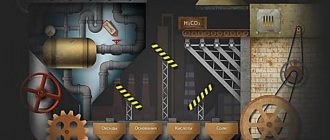The Stanislavsky system is what many successful people refer to. However, not everyone knows what it is and the essence of this phenomenon. If you like self-development, then you should, at least theoretically, know the Stanislavsky system.
Konstantin Sergeevich Stanislavsky
The Stanislavsky system is a theory of stage art, a method of acting technique. It was developed by the Russian director, actor, teacher and theater figure Konstantin Sergeevich Stanislavsky in the period from 1900 to 1910.
For the first time, the system solves the problem of consciously comprehending the creative process of creating a role, and determines the ways of transforming an actor into an image.
Naturally, Stanislavski used in his work important aspects of heuristics in general, and lateral thinking in particular. This is despite the fact that at that time these areas of science did not exist as independent disciplines.
The goal of Stanislavsky's system is to achieve complete psychological authenticity of acting.
The system is based on the division of acting into three technologies: craft, performance and experience.
- Stanislavski's craft is based on the use of ready-made cliches, from which the viewer can clearly understand what emotions the actor has in mind.
- The art of performance is based on the fact that during long rehearsals the actor experiences genuine experiences, which automatically create a form for the manifestation of these experiences, but during the performance itself the actor does not experience these feelings, but only reproduces the form, the ready-made external drawing of the role.
- The art of experience - the actor experiences genuine experiences during the game, and this gives birth to the life of the image on stage.
The system is fully described in the book by K. S. Stanislavsky, “The Actor’s Work on Oneself,” which was published in 1938.
Stanislavsky died in 1938, but his scientific achievements and creative understanding of human psychology are relevant to this day. In this article we will look at the 7 basic principles that make up the Stanislavsky system.
Action is the basis of performing arts
The Stanislavsky system is a rather conventional concept. The author himself admitted that a student can only learn skills and gain experience through close communication with the teacher.
That is, it is simply impossible to achieve a good result from a distance. It’s interesting that many people understand Stanislavsky’s system differently. Even its main conditions may differ for different actors or directors.
The principle of operation should be considered the central element of the system.
Action, in turn, is the basis of stage art, since any performance consists of many actions, each of which should lead to the achievement of a specific goal.
When building his role, the artist should not simply imitate the emotions and feelings of his character, because then his acting will turn out to be false.
On the contrary, the actor is obliged to try to build a chain consisting of simple physical actions. Thanks to this, his performance on stage will be truthful and natural.
Simple exercises to develop acting skills
Acting exercises can be considered anything that develops the basic qualities of an actor, listed in the subsection “acting self-development.”
Here are the simplest of those offered by acting training according to Stanislavsky:
- Imitation.
When in a crowded place, find a person who piques your interest and watch him. Come up with the necessary circumstances for him and try to reproduce a small fragment of his behavior yourself, trying not to miss a single characteristic feature. - Memory of physical actions.
Let us remind you that the right physical action can evoke the right emotion. Their non-objective reproduction will help develop a memory of physical actions. Simulate breakfast without food, dishes and cutlery, take a shower without a bath or water, draw without pencils and paper, etc. - I am in the proposed circumstances.
Develop your imagination by inventing unusual circumstances for yourself and trying to exist in them as truthfully as possible. Usually this exercise is performed in the form of sketches: the “pipe burst” sketch, the “first time at the skating rink” sketch, the “desert island” sketch, etc.
Don't play, but live
Truthfulness, in Stanislavsky's system, is one of the most important elements. No actor or director can portray something better than what exists in nature, in the real world.
Nature is both the main artist and the tool, which means it is what needs to be used. When performing in front of an audience, you must not just play the role, but live it entirely.
In the notes of Stanislavsky himself the following phrase is found: “During my show of Khlestakov, I also felt for minutes that I was Khlestakov in my soul.” Any role should become an important part of the artist himself.
But in order to achieve such a result, the speaker should use his life experience and imagination, thanks to which he will be able to believe that he is performing exactly the same actions as his hero.
In this case, all the components of the role and your acting tasks will not be far-fetched, but literally parts of yourself.
Analysis
A person is designed in such a way that he is often unable to analyze his own emotions. He fails to notice what he feels when he eats, walks or talks. We also do not tend to analyze the actions of other people.
An actor, on the contrary, must be a very good researcher. For example, he should examine in detail how his typical day goes. Or observe the behavior of a person trying to please the people he came to visit.
These and other observations should become habitual. Thanks to this, the actor or director will be able to collect certain information and gain experience. Among other things, he will be able to competently build a chain of physical actions, and therefore his character’s experiences.
Simplicity, logic and consistency
According to Stanislavsky, the score (chain) of physical actions should be as simple and clear as possible. Due to the fact that the artist has to perform hundreds of times in front of the audience, he must relive his role again and again, and with a complex scheme of actions, he will certainly get confused.
It will be much more difficult for him to express any emotions on stage, and for the viewer, in turn, it will be more difficult for him to analyze his performance. Stanislavsky believed that almost all people’s actions are very logical and consistent. Therefore, they should be the same during a theatrical production.
Logic and consistency must be present in everything: goals, desires, thoughts, emotions, actions and other areas. Otherwise, the same confusion will continue.
Basic principles of the system
The discoveries of Konstantin Sergeevich Stanislavsky forever pushed into the past the work of theater teachers, so to speak, in terms of methods: blindly, by touch, previously educating their students - adhering to the principle of “random advice”. Stanislavsky's greatest work, his system, contains the laws and principles of acting, among which stand out:
| A | The truth of experiences . The actor's emotions must be genuine. He should not mechanically portray his role; the first priority here is to believe in the “truth” of what he is doing, to internally live the fate of the character. Only by believing in the role as much as possible can you play it as authentically as possible. |
| B | Super task . The highest, main, comprehensive goal that must be achieved in stage action. “We need an emotional super task that excites our entire nature. “We need it like air and sun.” The main task of the actor is to convey to the viewer in the image of his character the main idea of the entire work, play, production. The ultimate task requires complete dedication from the actor, passionate aspiration, and all-exhaustive action. |
| C | Thinking through the proposed circumstances . The motivators of the character’s actions, the character’s life situation in which the actor places himself in his imagination. Here we can highlight the circumstances of a small circle: the situation with the hero at the current moment in time - where he is, with whom he is. The middle circle of circumstances concerns the general life situation: gender, age, status of the hero. And finally, a large circle - the situation of the character’s surroundings, the historical period, the country, the city where the events of the play unfold. |
| D | The birth of text and actions “here and now” . An important feature of an actor’s performance is the experience of “here” and “now”. Emotions and actions must be born on stage, not be clichés, which means they must be performed in a new way every time. |
| E | An actor's work on his own qualities. In order for the role to be as interesting and “alive” as possible, you need to use: imagination, observation (to record bright events and people in your life), emotional memory (to be able to remember what you experienced, the right feeling), to be able to manage your attention (to concentrate on partners, the game, stage). |
| F | Interaction with partners . Creativity in the theater is collective in nature, so it is very important for any actor to learn to interact with colleagues in the role. Stage partners should also help, support each other and be sure to feel the performance of each participant in the performance. |
We also urgently need to consider two more important components of the acting craft that contribute to its full development.
Overarching goal and cross-cutting action
One of the most important conditions of the Stanislavsky system is such a concept as a super task. Neither artists nor directors should in any way neglect the ideas of the author of the play for the sake of their own opinions.
The director is obliged to fully reveal the author's idea and try to express it on stage. And an actor, in addition to this, should also be as deeply imbued with the ideas of his characters as possible. The main task is to express the main idea of the work, since this is the main task of the performance.
All members of the acting team must try to achieve this goal. This can be achieved by identifying the main line of action that runs through all parts of the work and is called end-to-end action.
Konstantin Stanislavsky
Konstantin Sergeevich Stanislavsky (real name Alekseev) went down in Russian history as a great theater reformer, actor, director, theater director, theorist and teacher. The creator of the famous acting system, which has been extremely popular in Russia and in the world for 100 years.
Konstantin Alekseev was born on January 5 (17), 1863 in Moscow, into a large merchant family (he had nine brothers and sisters in total), related to the largest factory owners and philanthropists of that time - S.I. Mamontov and the Tretyakov brothers. Father - Sergei Vladimirovich Alekseev, mother - Elizaveta Vasilievna (nee Yakovleva). The mayor of Moscow, Alekseev, was his cousin. The younger sister is Zinaida Sergeevna Sokolova (Alekseeva), Honored Artist of the RSFSR. Konstantin Stanislavsky's grandfather, P. Alekseenko, was born in Ukraine and after his marriage moved to Moscow, where he changed his last name to Alekseev.
Stanislavsky began his stage activities in his youth. On September 5, 1877, Kostya Alekseev (he took the pseudonym Stanislavsky in 1885) performed for the first time in a home amateur performance. A circle of theater lovers formed around him, called Alekseevsky. In 1888, Stanislavsky, together with director A.F. Fedotov, singer and teacher F.P. Komissarzhevsky, artist F.L. Sollogub founded the Society of Art and Literature and created a drama troupe with it. In 1898, Stanislavsky, together with Vladimir Nemirovich-Danchenko, founded the Moscow Art Theater.
Already in the productions of the Alekseevsky circle and in other amateur performances, Stanislavsky’s remarkable acting talent was revealed. At that time he played many comedic roles in operettas and vaudevilles, Podkolesin in Gogol’s “The Marriage” and Neschastlivtsev in A. Ostrovsky’s “The Forest.” At the Society of Art and Literature, Stanislavsky's range of roles expanded. Along with comedic ones, he also created tragic characters, for example, Othello in Shakespeare’s tragedy and Uriel Acosta in Gutzkow’s play of the same name, acting as the director of these performances.
Stanislavsky’s first major independent directorial work was even earlier, in 1891, when he directed “The Fruits of Enlightenment” by L. Tolstoy. Stanislavsky saw in this comedy not just a ridicule of the spiritual squalor of the philistine aristocratic world, but, above all, a depiction of the bitter lot of the peasants. In Stanislavsky’s unusually diverse acting work (from Astrov in Chekhov’s “Uncle Vanya” and Satin in Gorky’s “The Lower Depths” to the brightly comedic roles of Krutitsky in the plays “Enough Simplicity for Every Wise Man” by Ostrovsky and Argan in Moliere’s “The Imaginary Invalid”), in his The director's activity reflected the fruitfulness of the principles of life's truth.
Stanislavsky's first production after the revolution was “Cain” by J.G. Byron (1920). Rehearsals had just begun when Stanislavsky was taken hostage during the White breakthrough to Moscow. The general crisis was aggravated at the Art Theater by the fact that a significant part of the troupe, led by Vasily Kachalov, who went on tour in 1919, found themselves cut off from Moscow by the military events of the Civil War.
The production of The Inspector General (1921) was an unconditional victory. For the role of Khlestakov, Stanislavsky appointed Mikhail Chekhov, who had recently transferred from the Moscow Art Theater (the theater had already been declared academic) to his 1st studio. In 1922, the Moscow Art Theater, under the direction of Stanislavsky, went on a long foreign tour of Europe and America, which was preceded by the return (not in full strength) of the Kachalovsky troupe.
Stanislavsky's activities in the 20s and 30s were determined primarily by his desire to defend the traditional artistic values of Russian stage art. Stanislavsky defined the task facing the artist this way: “Routine must be called theatricality, that is, the manner of walking and speaking in a special way on the theater stage. If so, then one should not confuse routine with the necessary conditions of the scene, since the latter undoubtedly requires something special that is not found in life. This is where the task lies: to bring life onto the stage, bypassing routine (which kills this life) and at the same time maintaining stage conditions.” Throughout his entire creative career, Stanislavsky sought a solution to this problem. In the course of these quests, he came to the discovery and definition of the laws of stage creativity, known as the Stanislavsky system. This system is the discovery of laws rooted in the nature of the actor’s creativity. Stanislavsky's system is inextricably linked with the art of experience, which its creator considered the highest expression of the principles of stage realism. Stanislavsky contrasted the art of experience with craft - the use of once and for all established cliches, and distinguished it from the art of representation, based on the mechanical repetition of a result achieved only once in the process of living experience. From the very beginning of his activity, Stanislavsky saw in the artist a bearer of high civic and ethical principles. This is where the doctrine of the super task arose - the main ideological goal for the sake of which the artist creates. Associated with the supertask is the concept of end-to-end action—a single main line of action.
After a severe heart attack that occurred on the anniversary evening at the Moscow Art Theater in 1928, doctors forever forbade Stanislavsky to appear on stage. Stanislavsky returned to work only in 1929, focusing on theoretical research, on pedagogical tests of the “system” and on classes in his Opera Studio of the Bolshoi Theater, which existed since 1918 (now the Moscow Academic Musical Theater named after K.S. Stanislavsky and V.I. Nemirovich-Danchenko).
At the end of his life, Stanislavsky came to the so-called method of physical actions, based on the recognition of the leading importance of the physical nature of action in mastering the inner life of a role. Physical action, in Stanislavsky’s understanding, is inseparable from the “life of the human spirit,” which the artist is called upon to reveal to the viewer. The system of Konstantin Sergeevich Stanislavsky - the wonderful legacy of the great master - is known and appreciated all over the world.
Stanislavsky died on August 7, 1938 in Moscow and was buried at the Novodevichy cemetery.
Collectivity
The ultimate task will become accessible only when all the artists join forces to work on the performance. Stanislavsky argued that mutual compliance and understanding of a common goal are extremely important.
When an artist tries to imbue himself with the ideas of an artist, writer or director, and an artist or writer with the desires of an actor, then everything will be great. Artists must love and understand what they are working on, and also be able to give in to each other.
If there is no mutual support in the acting team, the art will be doomed to failure. Many of you have probably heard Stanislavsky’s famous phrase: “Love the art in yourself, not yourself in the art.”


